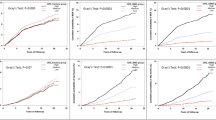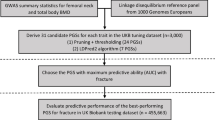Abstract
Summary
This study examined the use of polygenic risk scores (PGS) in combination with the Fracture Risk Assessment Tool (FRAX) to enhance fragility fractures risk estimation in osteoporosis patients. Analyzing data from over 57,000 participants, PGS improved fracture risk estimation, especially for individuals with intermediate to low risks, allowing personalized preventive strategies.
Introduction
Osteoporosis and fragility fractures are multifactorial, with contributions from both clinical and genetic determinants. However, whether using polygenic risk scores (PGS) may enhance the risk estimation of osteoporotic fracture in addition to Fracture Risk Assessment Tool (FRAX) remains unknown. This study investigated the collective association of PGS and FRAX with fragility fracture.
Methods
We conducted a cohort study from the Taiwan Precision Medicine Initiative (TPMI) at Taichung Veterans General Hospital, Taiwan. Genotyping was performed to compute PGS associated with bone mineral density (BMD). Phenome-wide association studies were executed to pinpoint phenotypes correlated with the PGS. Logistic regression analysis was conducted to ascertain factors associated with osteoporotic fractures.
Results
Among all 57,257 TPMI participants, 3744 (904 men and 2840 women, with a mean age of 66.7) individuals had BMD testing, with 540 (14.42%) presenting with fractures. The 3744 individuals who underwent BMD testing were categorized into four quartiles (Q1-Q4) based on PGS; 540 (14.42%) presented with fractures. Individuals with PGS-Q1 exhibited lower BMD, a higher prevalence of major fractures, and elevated FRAX-major and FRAX-hip than those with PGS-Q4. PGS was associated with major fractures after adjusting age, sex, and FRAX scores. Notably, the risk of major fractures (PGS-Q1 vs. Q4) was significantly higher in the subgroups of FRAX-major scores < 10% and 10–20%, but not in participants with a FRAX-major score ≧ 20%.
Conclusions
Our study highlights the potential of PGS to augment fracture risk estimation in conjunction with FRAX, particularly in individuals with middle to low risks. Incorporating genetic testing could empower physicians to tailor personalized preventive strategies for osteoporosis.



Similar content being viewed by others
Data availability
Data used in this article will be shared on reasonable request to the corresponding author.
References
(1991) Consensus development conference: prophylaxis and treatment of osteoporosis. Osteoporos Int 1(2):114–117
Johnell O, Kanis JA (2006) An estimate of the worldwide prevalence and disability associated with osteoporotic fractures. Osteoporos Int 17(12):1726–1733
LeBoff MS et al (2022) The clinician's guide to prevention and treatment of osteoporosis. Osteoporos Int 33(10):2049–2102
Cosman F et al (2014) Clinician's guide to prevention and treatment of osteoporosis. Osteoporos Int 25(10):2359–2381
Bliuc D et al (2009) Mortality risk associated with low-trauma osteoporotic fracture and subsequent fracture in men and women. Jama 301(5):513–521
Sànchez-Riera L et al (2014) The global burden attributable to low bone mineral density. Ann Rheum Dis 73(9):1635–1645
Harvey N, Dennison E, Cooper C (2010) Osteoporosis: impact on health and economics. Nat Rev Rheumatol 6(2):99–105
Nguyen ND et al (2005) Identification of high-risk individuals for hip fracture: a 14-year prospective study. J Bone Miner Res 20(11):1921–1928
Leslie WD et al (2007) Single-site vs multisite bone density measurement for fracture prediction. Arch Intern Med 167(15):1641–1647
Kanis JA et al (2005) Assessment of fracture risk. Osteoporos Int 16(6):581–589
Marques A et al (2015) The accuracy of osteoporotic fracture risk prediction tools: a systematic review and meta-analysis. Ann Rheum Dis 74(11):1958–1967
Jiang X et al (2017) Diagnostic accuracy of FRAX in predicting the 10-year risk of osteoporotic fractures using the USA treatment thresholds: A systematic review and meta-analysis. Bone 99:20–25
Ralston SH, Uitterlinden AG (2010) Genetics of osteoporosis. Endocr Rev 31(5):629–662
Morris JA et al (2019) An atlas of genetic influences on osteoporosis in humans and mice. Nat Genet 51(2):258–266
Torkamani A, Wineinger NE, Topol EJ (2018) The personal and clinical utility of polygenic risk scores. Nat Rev Genet 19(9):581–590
Wu S et al (2013) Genome-wide approaches for identifying genetic risk factors for osteoporosis. Genome Med 5(5):44
Choi SW, Mak TS, O'Reilly PF (2020) Tutorial: a guide to performing polygenic risk score analyses. Nat Protoc 15(9):2759–2772
Ho-Le TP et al (2017) Prediction of bone mineral density and fragility fracture by genetic profiling. J Bone Miner Res 32(2):285–293
Xiao X, Wu Q (2021) The utility of genetic risk score to improve performance of FRAX for fracture prediction in US postmenopausal women. Calcif Tissue Int 108(6):746–756
Eriksson J et al (2015) Limited clinical utility of a genetic risk score for the prediction of fracture risk in elderly subjects. J Bone Miner Res 30(1):184–194
Forgetta V et al (2020) Development of a polygenic risk score to improve screening for fracture risk: a genetic risk prediction study. PLoS Med 17(7):e1003152
Lu T et al (2021) Improved prediction of fracture risk leveraging a genome-wide polygenic risk score. Genome Med 13(1):16
Wu Q, Jung J (2023) Genome-wide polygenic risk score for major osteoporotic fractures in postmenopausal women using associated single nucleotide polymorphisms. J Transl Med 21(1):127
Xu C et al (2022) Association of air pollutants and osteoporosis risk: the modifying effect of genetic predisposition. Environ Int 170:107562
Nguyen TV (2017) Air pollution: a largely neglected risk factor for osteoporosis. Lancet Planet Health 1(8):e311–e312
Park S et al (2020) Gene-gene and gene-lifestyle interactions of AKAP11, KCNMA1, PUM1, SPTBN1, and EPDR1 on osteoporosis risk in middle-aged adults. Nutrition 79-80:110859
Lv X et al (2022) The role of metabolites under the influence of genes and lifestyles in bone density changes. Front Nutr 9:934951
Trajanoska K, Rivadeneira F (2019) The genetic architecture of osteoporosis and fracture risk. Bone 126:2–10
Xiao X, Wu Q (2023) The clinical utility of the BMD-related comprehensive genome-wide polygenic score in identifying individuals with a high risk of osteoporotic fractures. Osteoporos Int 34(4):681–692
Taiwan Precision Medicine Initiative, 2023. Clinical application moving toward precision health https://tpmi.ibms.sinica.edu.tw/www/en/screening/. [cited 2023 May 23].
Fan CT, Lin JC, Lee CH (2008) Taiwan Biobank: a project aiming to aid Taiwan's transition into a biomedical island. Pharmacogenomics 9(2):235–246
World Health Organization (1994) Assessment of fracture risk and its application to screening for postmenopausal osteoporosis : report of a WHO study group [meeting held in Rome from 22 to 25 June 1992]. World Health Organization
Wei CY et al (2021) Genetic profiles of 103,106 individuals in the Taiwan Biobank provide insights into the health and history of Han Chinese. NPJ Genom Med 6(1):10
Privé F et al (2022) Portability of 245 polygenic scores when derived from the UK Biobank and applied to 9 ancestry groups from the same cohort. Am J Hum Genet 109(1):12–23
Lambert SA et al (2021) The Polygenic Score Catalog as an open database for reproducibility and systematic evaluation. Nat Genet 53(4):420–425
Martin AR et al (2019) Clinical use of current polygenic risk scores may exacerbate health disparities. Nat Genet 51(4):584–591
Kanis JA et al (2011) Interpretation and use of FRAX in clinical practice. Osteoporos Int 22(9):2395–2411
Siris ES et al (2001) Identification and fracture outcomes of undiagnosed low bone mineral density in postmenopausal women: results from the National Osteoporosis Risk Assessment. Jama 286(22):2815–2822
Kanis JA et al (2008) FRAX and the assessment of fracture probability in men and women from the UK. Osteoporos Int 19(4):385–397
Nguyen ND et al (2007) Development of a nomogram for individualizing hip fracture risk in men and women. Osteoporos Int 18(8):1109–1117
Nguyen ND et al (2008) Development of prognostic nomograms for individualizing 5-year and 10-year fracture risks. Osteoporos Int 19(10):1431–1444
Michaëlsson K et al (2005) Genetic liability to fractures in the elderly. Archives of Internal Medicine 165(16):1825–1830
Deng HW et al (2000) Genetic determination of Colles' fracture and differential bone mass in women with and without Colles' fracture. J Bone Miner Res 15(7):1243–1252
Andrew T et al (2005) Risk of wrist fracture in women is heritable and is influenced by genes that are largely independent of those influencing BMD. J Bone Miner Res 20(1):67–74
Xiao X, Wu Q (2023) Validation of a genome-wide polygenic score in improving fracture risk assessment beyond the FRAX tool in the Women's Health Initiative study. PLoS One 18(6):e0286689
De La Vega FM, Bustamante CD (2018) Polygenic risk scores: a biased prediction? Genome Med 10(1):100
Popejoy AB, Fullerton SM (2016) Genomics is failing on diversity. Nature 538(7624):161–164
Xiao X, Wu Q (2023) Ethnic disparities in fracture risk assessment using polygenic scores. Osteoporos Int 34(5):943–953
Xiao X, Wu Q (2022) Multiple polygenic scores improve bone mineral density prediction in an independent sample of Caucasian women. Postgrad Med J 98(1163):670–674
Acknowledgements
We thank all participants and investigators from the Taiwan Precision Medicine Initiative.
Funding
This study was funded by Academia Sinica 40-05-GMM and AS-GC-110-MD02, National Science and Technology Council, Taiwan [NSTC -111-2634-F-A49-014, NSTC-111-2218-E-039-001, and NSTC-111-2314-B-075A-003-MY3], and Taichung Veterans General Hospital, Taiwan [TCVGH-1127301C, TCVGH-1127302D, TCVGH-YM1120110, and TCVGH-1127304B].
Author information
Authors and Affiliations
Contributions
J-J C conceived the study and drafted and revised the manuscript. J-J C, I-CC, Chia-Yi Wei, S-Y L, and Y-MC verified the analytical methods. S-Y L and Y-MC helped supervise the project. Y-MC formed the original hypothesis, designed the study, and drafted and revised the manuscript. All authors approved the final version of the manuscript.
Corresponding authors
Ethics declarations
Ethics approval and consent to participate
This study was reviewed and approved by the Institutional Review Board of Taichung Veterans General Hospital (CE23140B). All participants provided written informed consent according to the Helsinki Declaration.
Consent for publication
Not applicable.
Conflicts of interest
None.
Additional information
Publisher’s note
Springer Nature remains neutral with regard to jurisdictional claims in published maps and institutional affiliations.
Supplementary information
ESM 1
(PDF 200 kb)
Rights and permissions
Springer Nature or its licensor (e.g. a society or other partner) holds exclusive rights to this article under a publishing agreement with the author(s) or other rightsholder(s); author self-archiving of the accepted manuscript version of this article is solely governed by the terms of such publishing agreement and applicable law.
About this article
Cite this article
Chen, JJ., Chen, IC., Wei, CY. et al. Utilize polygenic risk score to enhance fracture risk estimation and improve the performance of FRAX in patients with osteoporosis. Arch Osteoporos 18, 147 (2023). https://doi.org/10.1007/s11657-023-01357-0
Received:
Accepted:
Published:
DOI: https://doi.org/10.1007/s11657-023-01357-0




